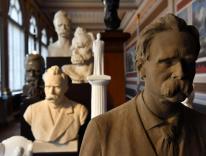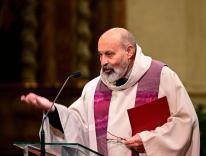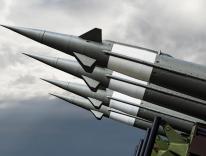
Earlier this year, around St. Patrick’s Day, journalist Timothy Egan was promoting his recent biography of American Civil War general Thomas Francis Meagher. Placing Meagher’s life into a broader historical context—he’d been banished, for political activities, from his native Ireland to Tasmania—Egan told NPR’s Leonard Lopate: “For almost seven hundred years it was a crime to be Irish in Ireland.... It was a crime to practice your religion...to own property.... [The English] did everything they could...to de-culture these people.”
All these years later, much popular Irish history is still viewed through the lens of English colonialism. But the authors and editors of The Princeton History of Modern Ireland offer a welcome corrective to such narrow thinking: they want readers to (if you will) look beyond “the Brits.”
“It is useful to examine the history of Ireland in [a] more flexible and complex framework,” writes co-editor Richard Bourke, a professor at Queen Mary University of London. “This reorientation helps us move beyond attempts to plot the story of Ireland as one of trauma or victimhood.” This theme is referred to again and again in the twenty-one articles included in this volume, which spans nearly five centuries, from Jane Ohlmeyer’s “Conquest, Civilization, Colonization: Ireland, 1540–1660” to Diarmaid Ferriter’s “Twenty-First-Century Ireland.”
In the former, for example, Ohlmeyer argues that “English imperialism in Ireland lacked any overriding, coherent, and consistent framework...allow[ing] some Catholics, together with many Protestant planters, to co-opt the colonial processes to strengthen their regional power bases.” In case the point is not clear, John Bew, in his essay “Ireland Under the Union, 1801–1922,” disapprovingly quotes Roy Foster’s assertion that “interpretations of the Union have often been ‘brutally simple: colonization as rape, union as shotgun marriage.’” Such one-dimensional accounts of Irish politics are mercifully absent from these essays.
Overall, The Princeton History of Modern Ireland makes a fine addition to the library of any reader looking to take a deeper dive into the diverse forces that have shaped Irish history. There are several—perhaps inevitable—drawbacks to such a project, such as the occasional lapse into obtuse academic language. “The centrality of violence to the historicist narrative of nationalism should be added to such pragmatic considerations,” writes Marc Mulholland in “Political Violence.” Not exactly the kind of prose that will stir the imagination of the non-specialist reader.
Another limitation is that, while the articles are necessarily broad, there are times when the subject matter begs for more details and deeper analysis. Take Maurice Walsh’s “Media and Culture in Ireland, 1960–2008,” an essay that tells the fascinating story of (among other things) the creation and evolution of Telefís Éireann, Ireland’s state television operation, which did not debut until New Year’s Eve 1961. “By the late 1950s television was no longer a distant abstraction, because households along the east coast were able to receive broadcasts from the British Broadcasting Corporation (BBC),” writes Walsh. He later adds, “If Ireland did not have its own version of the technology, the argument went, the country would end up swamped by British stations.”
Walsh commendably explores the unlikely television stardom of both Bishop Eamon Casey and Father Michael Cleary, emblematic products of a culture that craved mass entertainment, yet feared the moral damage it might do to a deeply Catholic country. That both of these men eventually became embroiled in sexual scandal—each secretly fathered children—makes them even more powerful symbols of the various cultural forces that roiled Ireland in the second half of the twentieth century. Readers may want to hear a lot more about this clash of religion, sex, and popular culture.
Other standout entries include explorations of the Irish language as well as the diaspora, topics that are often shoved to the margins but provide key insights into Ireland and its history.
Then there is Lauren Arrington’s impressive “Irish Modernism and its Legacies.” After an overview that touches upon the very different but equally important writers Liam O’Flaherty, J. M. Synge, and Elizabeth Bowen, Arrington focuses on the connections that link T. S. Eliot and the unjustly lesser-known Irish poet Thomas MacGreevy. Later, Addington perceptively notes: “Although Joyce and Beckett both chose to live the rest of their lives outside of Ireland and are often considered part of the international avant-garde, their work is nonetheless a reaction to the Irish revival.” This is an important reminder of the profound Irishness of two authors more typically associated with world literature.
RELIGION, OF COURSE, receives ample attention in this volume. Ohlmeyer’s essay as well as “Ascendancy Ireland, 1660–1880,” by Ultán Gillen, are both good on the tumult of rebellion and warfare that compelled a cycle of religious conversions and had grave consequences for Catholics and their ownership of land.
Co-editor Ian McBride’s essay—simply entitled “Religion”—is long and substantive if also, at times, opaque. McBride ably analyzes Ireland’s “obstinate religiosity” and offers genuine insight into a pressing question about Ireland in the wake of the 1840s Great Famine: “What accounts for the extraordinary success of the devotional revolution in turning the mass of the Irish people into practicing Catholics within a generation?” McBride reminds us that Irish Catholicism was not static in the nineteenth century, and (answering his own question) intriguingly ties faith to trends in demography and emigration as well as traditions of land inheritance.
McBride also observes that the “Protestant Ascendancy...above all was locked in a struggle with an international organization supported by the great imperial monarchies of Europe,” though this leaves the reader wondering why this volume does not have more to say about Ireland’s relationship with the Vatican. And readers familiar with the notorious twentieth-century anti-Catholic journalist Paul Blanshard will find Mcbride’s quotation of him questionable, even if it is meant to be ironic.
On a related, eternally vexing question of recent Irish history—Northern Ireland—The Princeton History of Modern Ireland offers much, but not, again, without the potential for controversy. (Now that clashes have generally left the streets of Derry and Belfast, they have marched on to the halls of academia.) Niall Ó Dochartaigh offers a thorough take on the North since 1920, though neither his essay nor Mulholland’s aforementioned “Political Violence” finds room to mention key events like, say, the Bloody Sunday massacre in Derry in January 1972.
In many ways, though, given what Ireland endured in the 1990s and 2000s—the sex-abuse revelations and a roaring, then battered, economy—such events can seem nearly as distant as the Easter Rising. Indeed, as was often noted during the Rising’s recent centenary, after centuries of dashed, rebellious dreams, Ireland finally began marching on the road to independence in 1916. And so there is no small irony in the fact that by the time the twenty-first century rolled around, the Irish people still found themselves (to use Diarmaid Ferriter’s words) “bereft of meaningful sovereignty.” No, they were not “reliant on” a distant colonial power or church authorities. The Irish, thanks to a housing bubble and banking mess, were held captive by a desperate need for “bailout funds.”
It’s hard to blame the Brits for that. Though not impossible.


